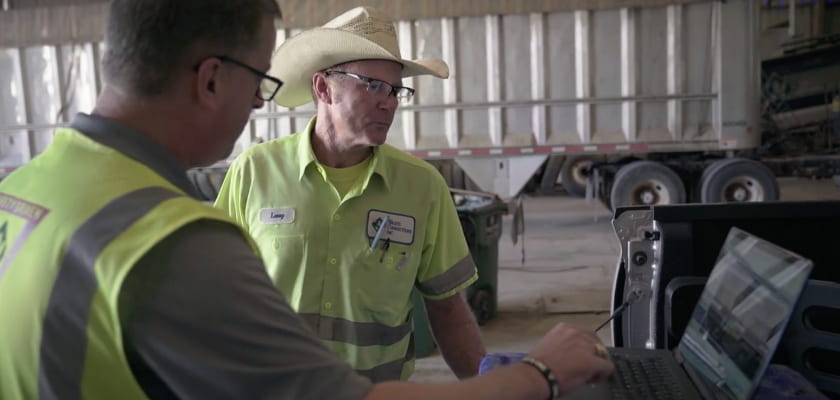The Interplay between Leadership and Technology

Leadership alone is not enough. And technology by itself can’t deliver success. So what’s the answer?
If you ask Ronald Mittelstaedt, the chief executive of Waste Connections Inc., he’d tell you that greatness happens when you connect the two.
“The real success comes at the intersection of technology used with appropriate leadership,” Mittelstaedt said during his keynote at the Lytx User Group Conference. “That is exponentially more powerful than an overabundance of technology that isn’t properly used, or leadership that is extremely strong, but doesn’t have the right data feeding into it.”
Mittelstaedt provided three case studies to make his point. The first was in the history of his own company, which has grown into the country’s third-largest waste services company through a combination of organic growth and more than 475 acquisitions since its founding in 1997.
The second was through Waste Connections’ 2016 acquisition of Progressive Waste Solutions. And the third was through the lens of a single service district within the company.
Although each case study offers unique lessons, Mittelstaedt combines them for maximum impact. Let’s unpack each case one by one.
Part 1: Waste Connections: A story of renewal
Imagine working for a company where your odds of being injured or involved in a fleet safety incident once a year are somewhere between 50 percent and 60 percent. That was Waste Connections up until 2009.
Last year, the company brought its rate of collisions and other safety-related incidents down to 12.9 percent.
What changed? Mittelstaedt, who founded the company, pointed to two things: leadership and technology. First, “we got our leadership hyperfocused on what accidents meant to the company and the lives of our employees,” he said. Instead of looking at injuries and collisions being the “cost of doing business,” Mittelstaedt and his team intentionally made safety a cornerstone of the company culture.
Second, “we instituted a point system” partly based on DriveCam data, he said. “The point system told us what was about to happen with that driver before the next incident happened. We used technology to get very surgical about what caused 80 to 90 percent of our accidents and injuries. It became very, very accurate.”
Part 2: Progressive Waste Solutions: A story of transformation
Last year, Mittelstaedt’s company acquired Progressive Waste Solutions (PWS). On the surface, both companies had a lot in common. “Same size as us. Same types of trucks. Same types of roads,” he said. But where Waste Connections had one fatality in the previous five years, PWS had 37. Six of those deaths occurred in the first five months of 2016.
In the 10 months after the deal closed on June 1, PWS’s incident rate dropped 60 percent, with no fatalities.
What happened? Two things: leadership focus and more effective use of technology, according to Mittelstaedt. Leaders became accountable to front-line employees, and drivers could decline accounts that they think are too hazardous.
In addition, PWS began using Waste Connections’ point system, proactively using Lytx data to coach and change risky behaviors.
Even though PWS shed $40 million in revenue as a result of drivers declining to service contracts they felt were too risky, the company’s margins actually increased from 24 percent to 30 percent. Eliminating “risk accounted for half of that financial improvement,” Mittelstaedt said.
Part 3: Colorado Springs: A story of redemption
Every company has trouble spots. Maybe it’s a division that has high turnover. Or a group that chronically underperforms. For Waste Connections, it was the company’s Colorado Springs district. In 2014, the company appointed a new manager named Kevin Malone to the district.
“You can make a difference in the lives of many people. And nothing is more important than our people and the people in the community we operate in. Proper leadership with the right technology can get you there. Don’t let that opportunity pass you by.”
– Ronald J. Mittelstaedt, founder and chief executive, Waste Connections Inc.
The result: “In under a year, it went from one of the worst performing districts in the company in risk to one of the best,” Mittelstaedt said. The district’s incident rate dropped 72 percent in 12 months. In addition, Mittelstaedt said, “Margins went up. Morale went up. What changed? Leadership.”
“Kevin is a consummate servant leader,” he said. “He’s on the front lines with his people every day. He’s hands on, and he accepts the accountability for the success or failure of his people. He understands that safety is an indicator of his leadership. He accepts that. And he uses technology to tell him what to do.”
Tragically, Malone passed away in March of this year.
“I talk about Kevin because he’s an example of what each of you has the opportunity to do. You can make a difference in the lives of many people. And nothing is more important than our people and the people in the community we operate in. Proper leadership with the right technology can get you there,” Mittelstaedt said. “Don’t let that opportunity pass you by.”
Learn more about the fundamentals of a strong safety culture through this helpful webinar.
